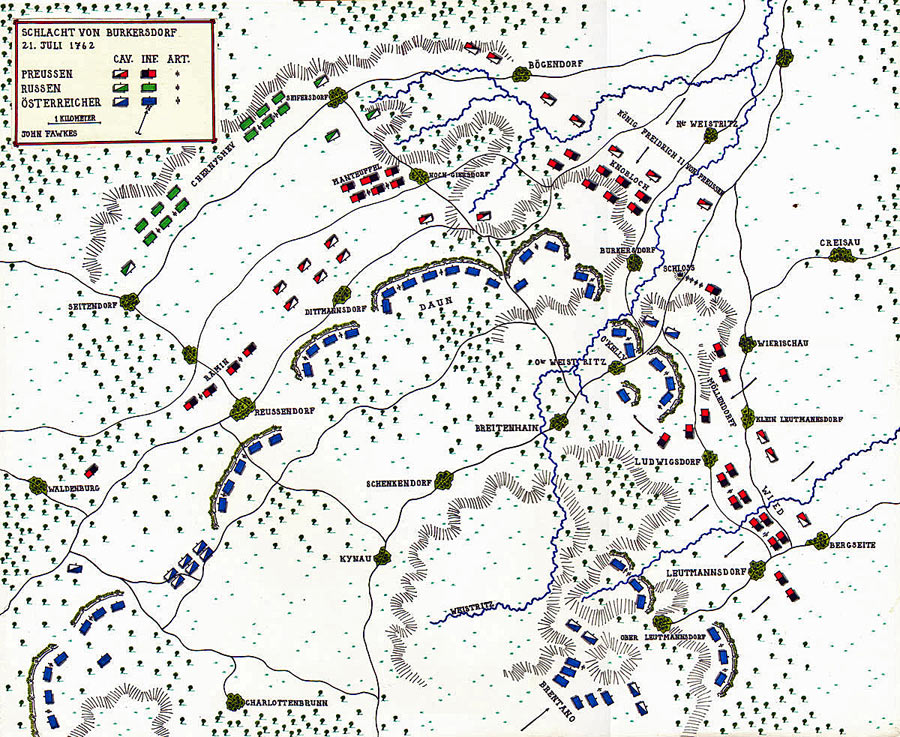Frederick the Great’s final battle of the Seven Years War, fought on 21st July 1762
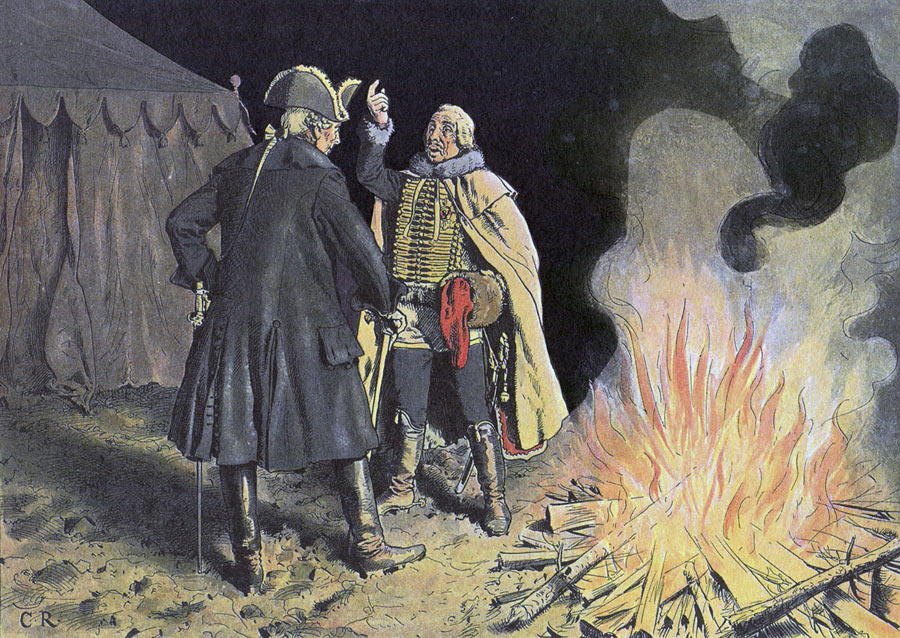
Frederick the Great talks to General Zieten in the Camp at Bunzelwitz before the Battle of Burkersdorf on 21st July 1762 in the Seven Years War: picture by Richard Knötel
The previous battle in the Seven Years War is the Battle of Torgau
The next battle in the Seven Years War is the Battle of Minden
Battle: Burkersdorf
Date of the Battle of Burkersdorf: 21st July 1762
Place of the Battle of Burkersdorf: Near Schweidnitz in Central Silesia.
War: The Seven Years War.
Contestants at the Battle of Burkersdorf: Prussians against an Imperial Austrian Army comprising the various nationalities that made up the Austrian Army (Austrians, Hungarians, Bohemians, Silesians, Croats, Italians and Moravians). A Russian army was present but took no active part other than to appear to the Austrians that it might intervene on the side of the Prussians.
Generals at the Battle of Burkersdorf: King Frederick II of Prussia, known as Frederick the Great, commanded the Prussian Army against Marshal Daun commanding the Austrian Army. The Russian army was commanded by General Chernyshev.
Size of the Armies at the Battle of Burkersdorf: Prussians: around 40,000 men. Austrians: around £45,000 men: Russians: around 20,000 men.
Winner of the Battle of Burkersdorf: The Prussians.
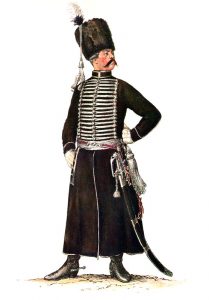
Prussian Bosniaken-Regiment No 9: picture by Adolph Menzel as part of his series of pictures ‘Die Armee Friedrichs des Grossen in ihrer Uniformierung’
Uniforms and equipment at the Battle of Burkersdorf: The Prussian infantry and artillery wore a dark blue coat turned back at the lapels, cuffs and skirts with britches and black thigh length gaiters. From cross belts hung an ammunition pouch, bayonet and ‘hanger’ or small sword. Headgear for the line companies was the tricorne hat with the receding front corner bound with white lace. Grenadiers wore the distinctive mitre cap with the brass plate at the front. Fusilier Infantry Regiments and gunners wore the smaller version of the grenadier cap.
The infantry carried the musket as their main weapon. The single shot musket could be loaded and fired by a well trained soldier between 3 and 4 times a minute. During the course of his wars Frederick introduced the iron ramrod and then the reversible ramrod which increased the efficiency of his infantry, the wooden ramrod being liable to break in the stress of battle.
The Prussian infantry regiment was based on the cantonment, with soldiers joining their local regiment. Soldiers were released for key agricultural times such as sewing and harvesting. In the autumn reviews were conducted of all regiments to check that each regiment was up to the required standard. Each year certain regiments were selected to conduct the review at Potsdam under the eye of the King. Officers whose soldiers were considered by Frederick not to be of a sufficient standard were subjected to a public tongue lashing and in extreme cases dismissed on the spot.
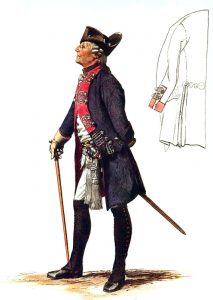
Prussian Infantry Regiment Prinz von Preussen No 18: picture by Adolph Menzel as part of his series of pictures ‘Die Armee Friedrichs des Grossen in ihrer Uniformierung’
The efficiency of the Prussian regiments at drill enabled them to move around the battlefield with a speed and manoeuvrability that no other European Army could equal.
Heavy cavalry of the period comprised cuirassiers, whose troopers wore steel breastplates, and dragoons. The main form of light cavalry were the regiments of hussars. The Austrian hussars were Hungarian and the genuine article while the hussars of other armies were given the same dress as Hungarian hussars and expected to perform to similar standards.
The Prussian cuirassiers wore a white coat, steel cuirass, white britches and thigh boots. The headgear was the tricorne hat. Dragoons wore a light blue coat. Weapons were a heavy cavalry sword and single shot flintlock carbine.
The light cavalry arm was provided by the Prussian Hussar regiments. Frederick found the Prussian Hussars as inadequate for their role as the heavy cavalry regiments. Following Mollwitz and in particular after the First Silesian War the hussars were re-organised and re-trained to provide a first class scouting and light cavalry service. Frederick found in Colonel von Zieten the ideal officer to implement the improvements in the hussar regiments. The Prussian Hussars wore the traditional hussar dress worn by the original Hungarian Hussars of tunic, britches, dolman (slung jacket), busby (fur hat) with bag, sabretache (leather wallet on straps) and curved sword.
The Austrian infantry wore white coats with lapels, cuffs and skirts turned back showing the regimental lining colour. Headgear was the tricorne hat for line infantry and bearskin cap for grenadiers. The infantry weapons were musket, bayonet and hanger small sword. Heavy cavalry wore white coats and hats as for the infantry and were armed with a heavy sword and carbine. The Austrian army contained a large number of irregular units such as the Pandours from the Balkans who wore their ethnic dress without uniformity. Hungarian Hussars provided the light cavalry arm. These Hussars were dressed as described for the Prussian Hussars, were considered to be little more than bandits but were highly effective in all the roles required of light cavalry.
In most respects the Russian army mirrored that of the western powers in structure, uniforms and weapons. The Russian infantry wore green coats. The cavalry comprised cuirassier, dragoon and hussar regiments. The Russians relied upon a large force of Cossack irregular cavalry. The Cossacks pillaged far and wide and were of limited use to the Russian commanders, often being too busy looting to spend much time on the pursuits of scouting and harassing enemy troops.
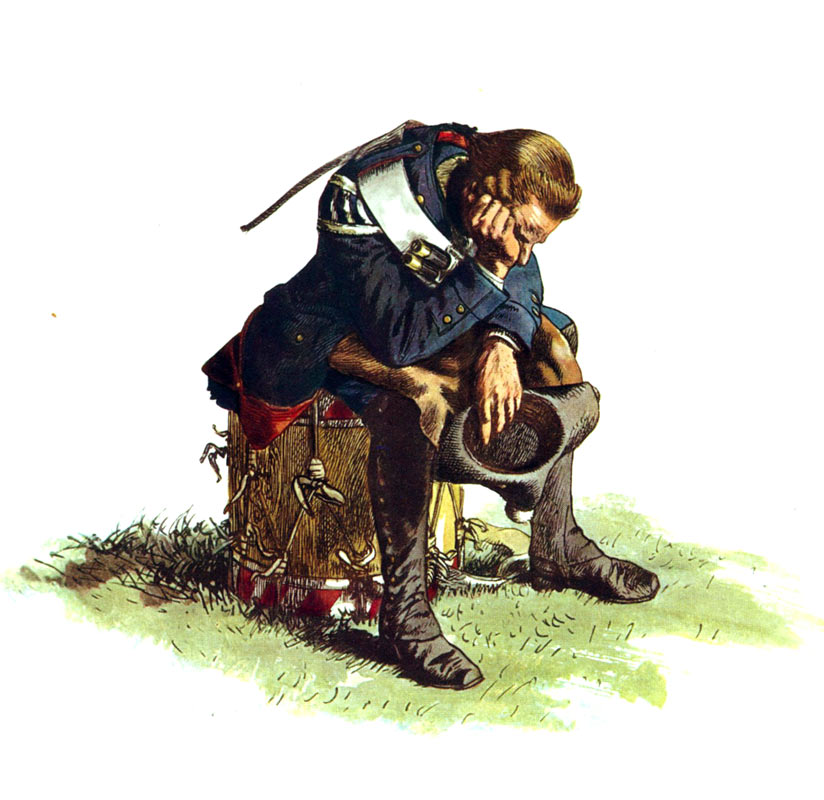
Prussian Infantry Drummer: picture by Adolph Menzel as part of his series of pictures ‘Die Armee Friedrichs des Grossen in ihrer Uniformierung’
The artillery of each army was equipped with a range of muzzle loading guns. The Prussian Artillery was considerably more efficient at manoeuvring on the battle field. In the changes implemented by Frederick after the First Silesian War horse artillery was introduced to support the Prussian cavalry.
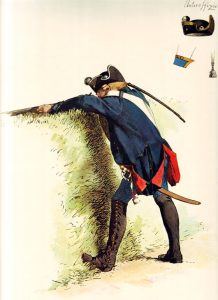
Prussian Infantryman: picture by Adolph Menzel as part of his series of pictures ‘Die Armee Friedrichs des Grossen in ihrer Uniformierung’.
The Battle of Torgau, fought on 3rd November 1760, although a victory for Frederick the Great over the Austrians and Saxons, was not the decisive battle he was seeking. Frederick spent the rest of the winter in Leipzig recovering his health and reconstructing his battered army.
In 1761 Frederick took the field but avoided battle with the Austrians. His aim was to prevent a junction between the Austrian army and the Russians, at that stage in the Seven Years War still allied against the Prussians. In late August 1761 Buturlin with a Russian force evaded Frederick and joined the Austrians creating a combined army of around 120,000 men (72,000 Austrians and 47,000 Russians).
In order to preserve his Prussian army Frederick constructed a fortified camp near the town of Schweidnitz one of his principal magazines. The camp took its name from the small town of Bunzelwitz and has entered Prussian military legend as the ‘Camp at Bunzelwitz’. Incorporating a number of villages and hills into the works the Prussian army toiled night and day to complete the fortified camp, beginning on 20th August 1761 and completing the camp within a few days.
The Austrians and Russians threatened an assault on the Camp at Bunzelwitz and an attack was planned to begin on 1st September1761. The Russians after initially agreeing to the planned assault vetoed the attack at the last moment.
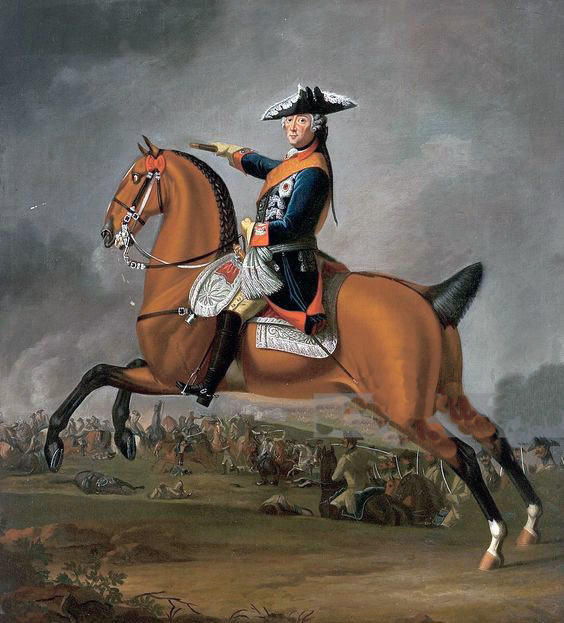
Frederick II, King in Prussia, ‘Frederick the Great’:Battle of Burkersdorf on 21st July 1762 in the Seven Years War: picture by David Morier
The main force of Russians withdrew to the east bank of the Oder River leaving the Austrian commander Loudoun in the vicinity of the Prussian camp. Frederick made one of his unfortunate miscalculations broke camp and marched towards Neisse to the South East where there were supplies available to his army, the magazines at Schweidnitz being significantly depleted. On the night of 30th September 1761 the Prussians heard distant cannon fire and the next day Frederick’s army received the catastrophic news that Loudon had stormed Schweidnitz and captured the town.
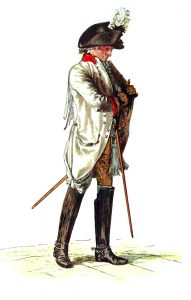
Prussian Cavalry Adjutant: picture by Adolph Menzel as part of his series of pictures ‘Die Armee Friedrichs des Grossen in ihrer Uniformierung’
On 5th October 1761 William Pitt the British Prime Minister resigned, to be replaced by Lord Bute. The system of subsidy paid by Britain to Prussia ended with the change of government in London.
It looked as if 1762 would see the final collapse of Prussia with the overwhelming of its depleted army by the Austrians and Russians.
However on 5th January 1762 Empress Elizabeth of Russia, Frederick’s most implacable foe after the Empress Maria Theresa of Austrian, died. Elizabeth was succeeded by the Tsar Peter, a devoted admirer of Frederick the Great. On 27th January 1762 Frederick received the news that Peter had ordered the Russian forces to cease hostilities against the Prussians. Frederick awarded Peter the Order of the Black Eagle and appointed him colonel of a Prussian infantry regiment. In early June 1762 Peter entered into alliance with Frederick and the Russian army joined Frederick to fight against their erstwhile allies, the Austrians.
It was clear to both sides that the war had almost run its course. The one advantage left to play for was Schweidnitz which would inevitably prove to be a significant bargaining counter in the peace negotiations.
Further manoeuvring took place with skirmishes between the opposing sides during which the Austrians under Marshal Daun fell back to a camp around the village of Burkersdorf from where they maintained contact with the Austrian garrison in Schweidnitz. Frederick’s main force occupied the old ‘Camp at Bunzelwitz’.
On 18th July 1762 the Russian commander General Chernyshev informed Frederick that the Tsar Peter had been deposed in a palace revolution and that his army was under orders to withdraw into Russian territory. Frederick persuaded Chernyshev to delay the Russian departure for 3 days while he attacked the Austrians.
Account of the Battle of Burkersdorf:
The main Austrian positions lay behind substantial fieldworks on the south side of the valley containing the villages of Dittmannsdorf and Reussendorf. Frederick’s plan was to ‘fix’ those forces with a show of strength by the lingering Russian army and some Prussian units under General Ramin and General Manteuffel.
The principal Prussian attack was to take place in oblique form starting on the extreme Austrian right in the area of the village of Leutmannsdorf, followed in turn by attacks on the Austrian positions on the hill tops around the villages of Ludwigsdorf and Ober Weistritz. Frederick intended to supervise these operations in person. Austrian strength on this refused right flank was much weaker than in their main positions, although the return of General Brentano’s corps from a detached task would provide last minute reinforcements.
General Weid commanded the extreme Prussian left wing and it took him 3 days of forced marches through near constant rain to get his units in place for the attack.
On the evening of 20th July 1761 General Möllendorf took the castle at Burgersdorf and the Prussian artillery established a fortification near the castle to conceal a row of 55 artillery pieces ready to bombard the Austrian positions further up the valley.
In the early hours of 21st July 1761 Frederick reached Weid’s troops and ordered the attack to begin.
The Prussian infantry attempted to storm the Austrian positions around Ober Leutmannsdorf, but at the moment of the assault General Brentano’s leading battalions arrived to bolster the position and the Prussians were thrown back. 2 further Prussian battalions were sent to reinforce the assault and the Austrians were driven back.
As the next phase in the Prussian attack Colonel Lottum stormed the heights around Ludwigsdorf with 2 regiments (No 22 and No 10).
Once it was clear that the Prussian attack was succeeding Frederick rode on to Burkersdorf. The Prussian battery of 55 guns had opened fire with such effect that 2 Austrian cavalry regiments had been destroyed before they could mount up for battle. In the ensuing infantry attack Möllendorff’s men climbed a hill path and infiltrated around the right flank of the Austrian positions before driving in their assault. This action combined with Manteuffel’s attack from the north caused the Austrians to abandon their positions and retreat.
On the following day, 22nd July 1761, Daun withdrew from his positions and retreated to the hills of Glatz, effectively losing his communications with Schweidnitz.
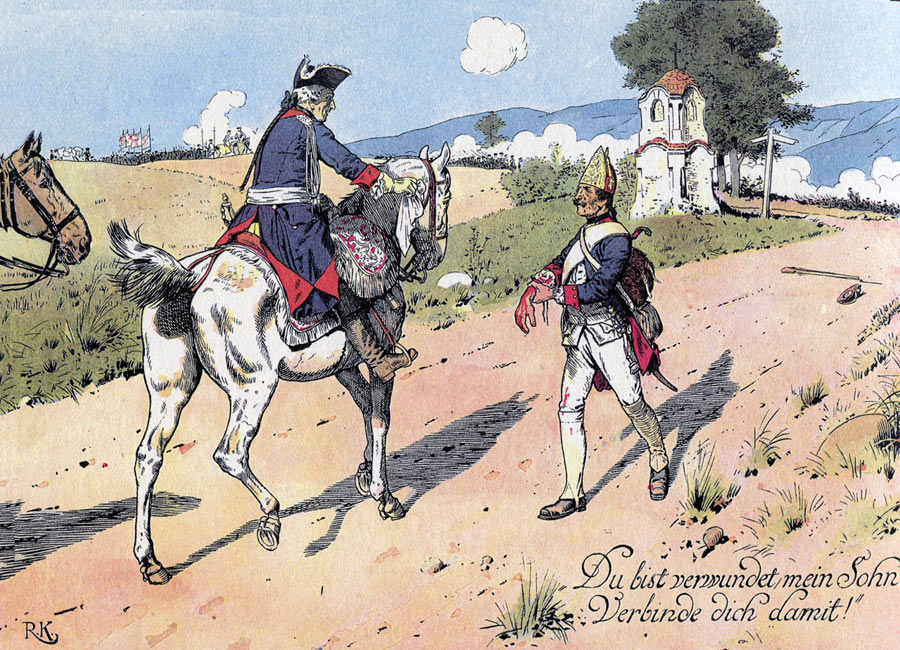
Frederick the Great greets a wounded Prussian fusilier and gives him his scarf to bind his wound during the Battle of Burkersdorf 21st July 1760 in the Seven Years War: picture by Richard Knötel
Casualties at the Battle of Burkersdorf: Prussian losses: 1,600 men killed, wounded and captured. Austrian losses: 2,500 men killed, wounded and captured.
Aftermath to the Battle of Burkersdorf:
Following the Battle of Burkersdorf the Prussians put the Austrian garrison in Schweidnitz under siege. Frederick kept a close watch on the passes leading from the Country of Glatz into Silesia to ensure that Daun could not come to the relief of the town.
In August 1761 Daun mounted an attack on the force commanded by the Duke of Bevern as a prelude to relieving Schweidnitz. Frederick brought up a cavalry force in support of Bevern and the Austrians were beaten back. This was Daun’s last effort to lift the Prussian grip on the town.
In December 1762 serious negotiations to end the war were started and the Treaty of Hubertusburg was signed on 15th February 1763. Prussia was confirmed in possession of Silesia and Glatz and in exchange agreed to evacuate its troops from Saxony.
Once the treaty was concluded Frederick returned to Berlin to resume the life of a civilian ruler. The crowds turned out to greet Frederick as a returning victor. Frederick evaded them and slipped into his palace after dark. He is said to have been at his desk the next morning.
Frederick found, to his wry amusement, that he had become a European hero and was being referred to as ‘Frederick the Great’.
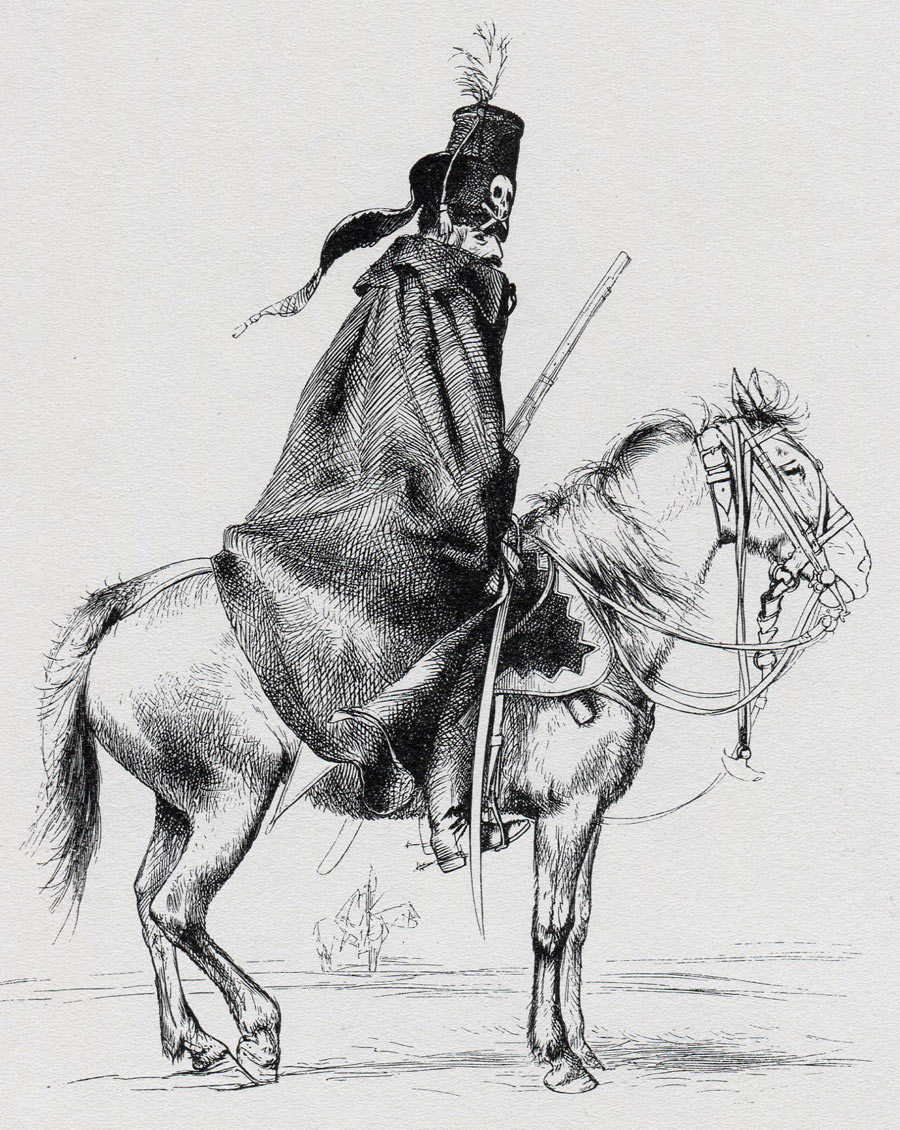
Prussian 4th Totenkopf Hussars: Battle of Burkersdorf 21st July 1760 in the Seven Years War: picture by Adolph Menzel
Anecdotes from the Battle of Burkersdorf:
- Immediately after the successful Prussian attack on Ludwigsdorf and once he had seen that Lottum’s men had taken the Austrian positions Frederick sent a message to Colonel Lottum promoting him to major general.
- The abattis preventing the Prussians from entering Ober Weistritz was dealt with by a single Prussian grenadier called Wolf who set fire to the abattis and burnt a way through for his comrades.
- At the moment of victory in Ober Weistritz the Prussians lost one of their most distinguished younger officers, First Lieutenant Cunno Frederich von der Hagen, who was shot through the head and killed.
- The Battle of Burkersdorf is well known for the incident in which Frederick met a Prussian fusilier leaving the scene of the fighting around Ober Weistritz with a wound in his arm. Frederick asked the soldier how the fighting was going. The fusilier replied ‘Very well, thank God. The enemy are on the run. We have beaten them’. Seeing the wound Frederick gave the soldier his handkerchief to bind it up. General Chernyshev was riding with the Prussian King and exclaimed ‘I see why men serve your Majesty with such zeal. You are so kind to your soldiers.’
References for the Battle of Burkersdorf:
- Frederick the Great by Thomas Carlyle
- Frederick the Great by Christopher Duffy
- The Army of Frederick the Great by Christopher Duffy
- The Army of Maria Theresa by Christopher Duffy
- Russia’s Military Way to the West by Christopher Duffy
The previous battle in the Seven Years War is the Battle of Torgau
The next battle in the Seven Years War is the Battle of Minden
